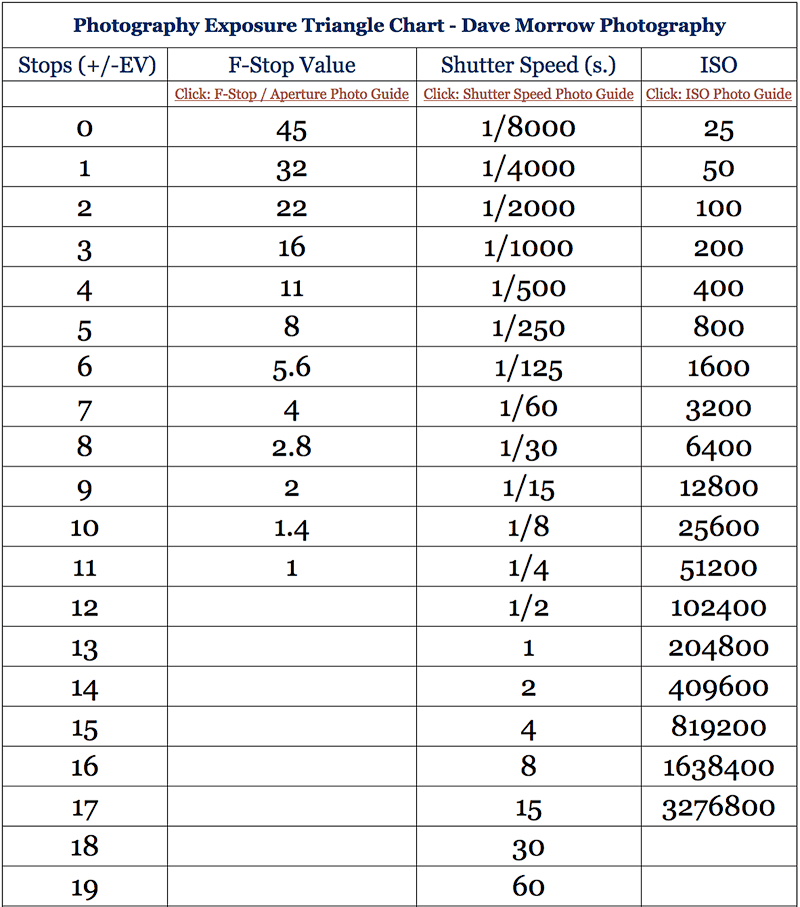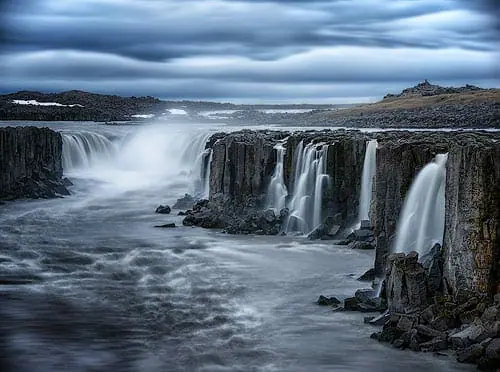
Using this shutter speed chart and guide, you’ll learn to improve your photos for:
- Long exposures
- Action shots
- Outdoor photography
- Night sky photography
Take complete creative control over your images, with the step by step techniques provided below.
Scroll down & get started!
Table of Contents
- Shutter Speed Chart & Camera Technique Video
- Shutter Speed & Exposure Time Basics
- Exposure Stops & Shutter Speed
- Example Images & Creative Control
- Best Shutter Speed for Handheld Photos
- Improve Image Quality with Shutter Speed
- Test & Compare Shutter Speeds
- Choosing the Correct Shutter Speed
- How to 10X Your Learning Speed
Shutter Speed Chart & Camera Technique Video
Shutter speed photography settings control two important factors within an image:
- Motion Blur: Example, smooth water produced by long shutter speeds or fast-moving objects frozen with sharp focus, produced by short shutter speeds.
- Image Brightness: Length of time light is exposed to the camera sensor, which determines the overall exposure.
This video covers my basic technique for using shutter speed to control specific parts of the image.
Watch it first to get an overview, then learn to use the shutter speed chart in the following sections.
Shutter Speed & Exposure Time Basics
To create an image, light passes through the lens aperture where it’s exposed to the camera sensor.
The camera sensor collects & records light information about the scene being photographed.
Shutter speed controls the length of time the sensor is exposed to light from the scene.
This is also a factor in determining image brightness.
What is a Camera Shutter?
Think of a camera shutter as a door, inside the camera body, that covers the camera sensor.
- When the shutter (door) is closed, the sensor does not collect light information from the scene.
- When the shutter (door) is open the sensor starts collecting light information from the scene.
When you push the shutter button to take an image, the shutter opens and the sensor is exposed to light for the amount of time denoted by the shutter speed setting.
Technical Note: DSLR cameras have a physical shutter. Mirrorless cameras do not. Other than this fact shutter speed works in the same manner for both.
Exposure Time vs. Shutter Speed
Shutter speed controls the exposure time.
For example, a shutter speed of 2 seconds, exposes the image sensor to light for 2 seconds.
This is known as a 2 second exposure time.
Once this exposure time has elapsed, the shutter closes and the sensor is no longer exposed to light.
What is Motion Blur in Photography?
When different elements in the composition move during the exposure, such as:
- water
- stars & planets
- trees
- animals
Each pixel will show the average of the color and light collected during the exposure time.
Using varying shutter speeds the photographer can add “interestingness” to the photo by showing movement in a still picture.
The following images show some examples of water.
Motion Blur – 1 Second Shutter Speed
The following photo shows a slight motion blur.
The water is much smoother with less detail.
You could increase the motion blur by lengthening the shutter speed.
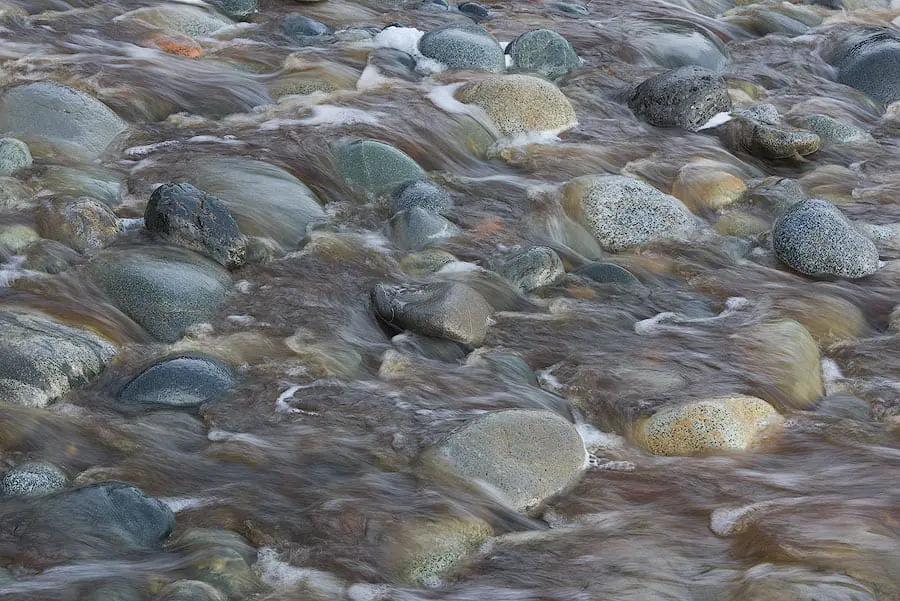
No Motion Blur – 1/1000 Second Shutter Speed
The next photo shows no motion blur.
The water looks as it would to your eye.
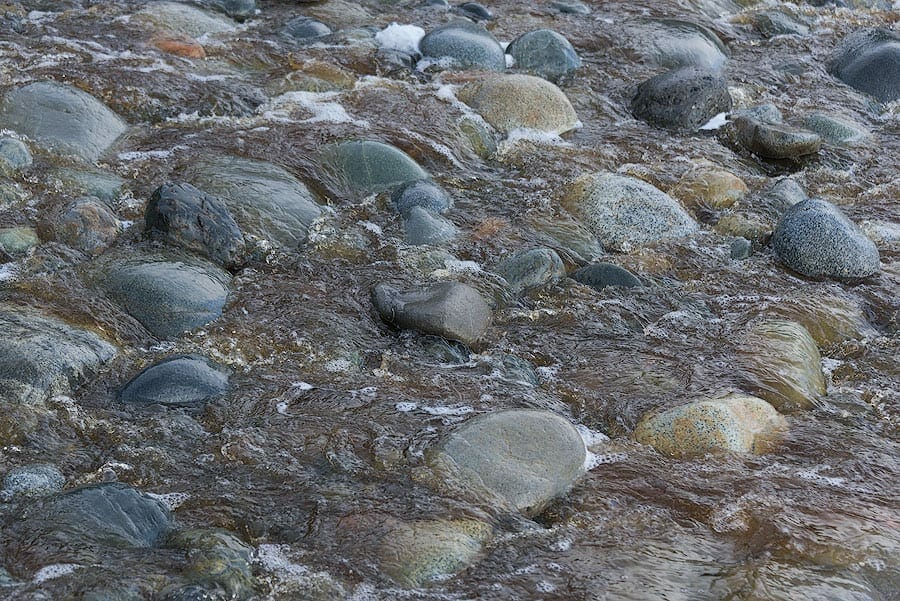
For every photo, each pixel shows the average of the color and light it collects over the given shutter speed.
Motion blur is a function of shutter speed, focal length, and speed of the object moving through the composition.
Experimentation is key to learning how motion blur works.
In the following sections, we will discuss this topic in detail.
Exposure Stops & Shutter Speed
An exposure stop, or stop for short, provides a universal scale to measure the increase and decrease in light, exposed to the image sensor, due to changes in shutter speed & f-stop.
- For ISO, exposure stops provide the increase or decrease in signal (light information) amplification, thus how much light is required to produce the optimal exposure.
- Overall, stops provide an easy way for the photographer to increase or decrease image brightness or adjust specific f-stop, ISO, and shutter speed settings while balancing the exposure triangle.
Adjusting Shutter Speed Using Stops
Reference the shutter speed chart, while reading the following section.
The Stops Column shows the difference in stops between varying shutter speeds.
The Shutter Speed Column shows different standard shutter speeds in 1 stop intervals.
- Specific stops don’t directly correlate to specific shutter speed values.
- Stops allow you to easily compare the amount of light captured by one shutter speed setting compared to another.
This makes it easy to increase or decrease the image brightness & balance the exposure triangle without guessing.
Lengthening the shutter speed, producing a longer exposure time, allows the image sensor to collect more light information, producing a brighter image with increased motion blur.
This is known as stopping up.
Shortening the shutter speed, producing a shorter exposure time, forces the image sensor to collect less light information, producing a darker image with less motion blur.
This is known as stopping down.
An Example of Shutter Speed & Exposure Stops
You can track these changes using the shutter speed chart while looking at the following examples.
The images show a 1 stop increase in shutter speed with no changes to ISO or f-stop.
As motion blur & shutter speed increases the water becomes less and less detailed, with increased smoothness.
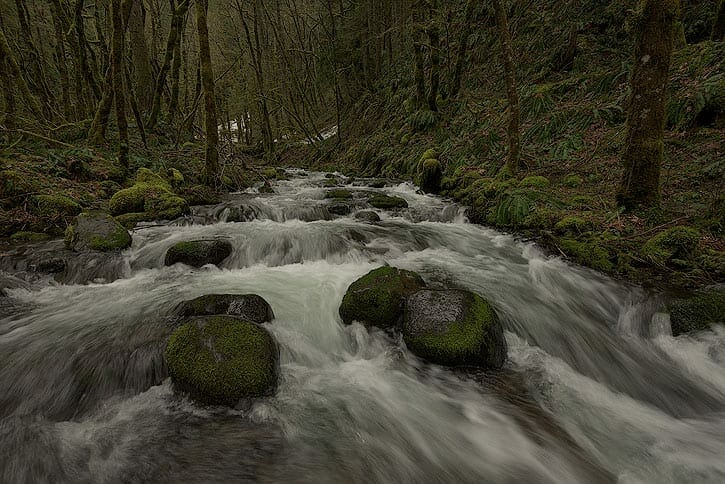
Settings: 1/15 second, f/11, ISO50
As the images progress, stopping up in shutter speed, they become brighter with increased motion blur.
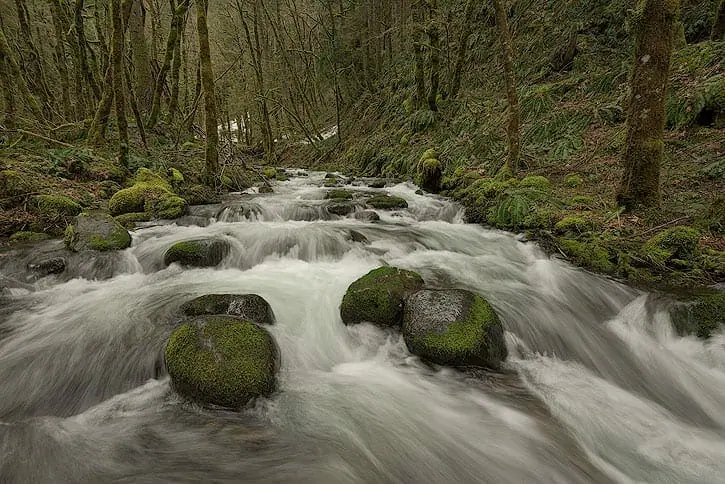
Settings: 1/8 second, f/11, ISO50
Notice, in each image, the water becomes more and more smooth.
Remember, f-stop & ISO are staying constant for this example.
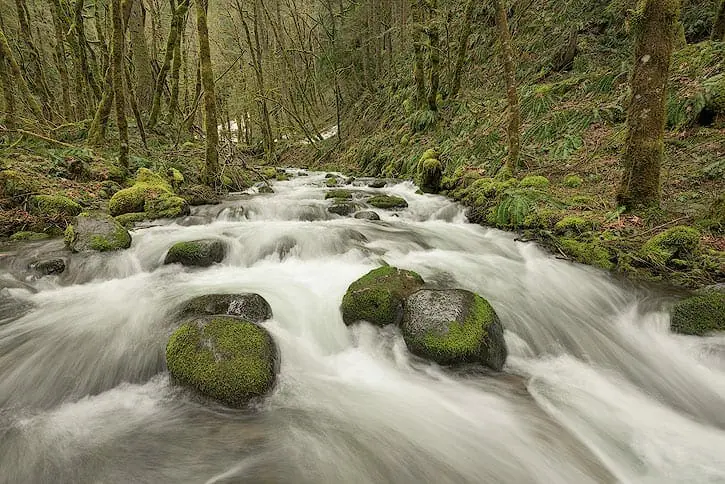
Settings: 1/4 second, f/11, ISO50
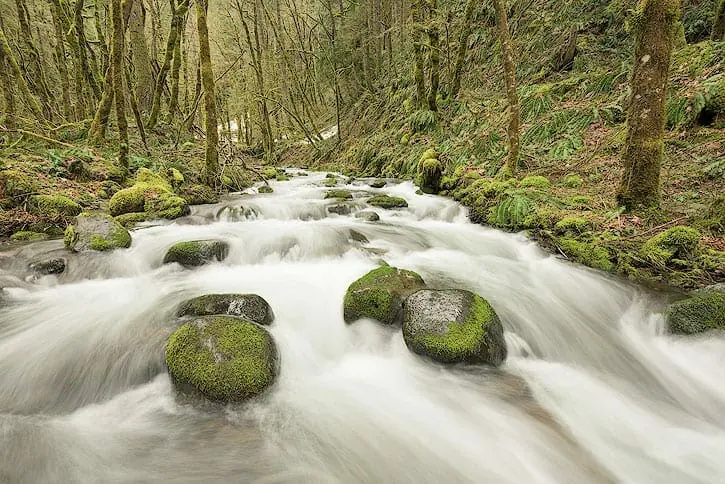
Settings: 1/2 second, f/11, ISO50
To maintain constant image brightness, while increasing or decreasing shutter speed, changes in ISO or f-stop must be made by the same number of stops in the opposite direction.
For example, a stop up in shutter speed would require a stop down in ISO, f-stop, or a combination of both, to maintain the same image brightness.
This is taught in my Exposure Triangle Photography Guide.
Shooting Example – Using Stops & Shutter Speed
Let’s say you took an image with a shutter speed of 4 seconds, f/8, ISO100, and noticed it was too bright.
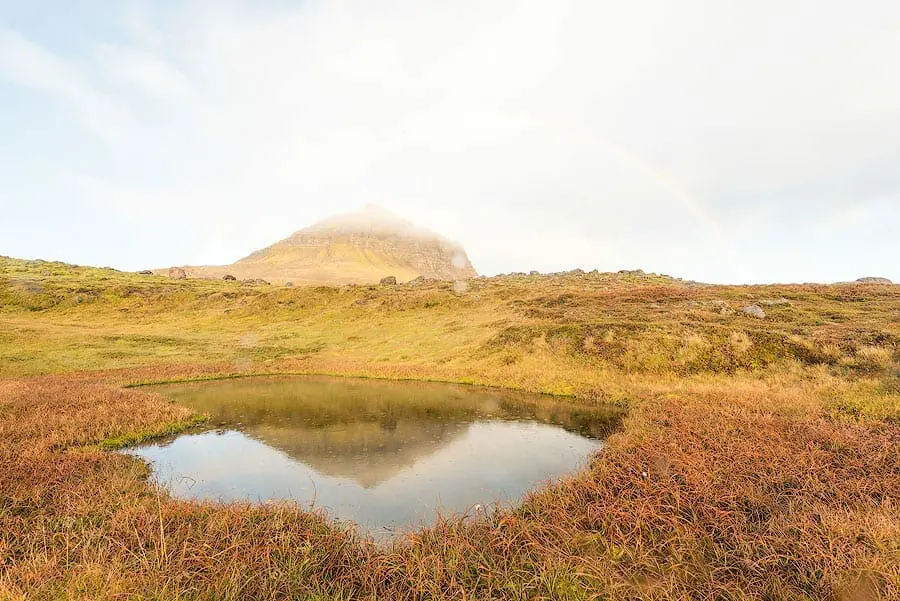
You thought to yourself, “If only this image contained half the amount of light it would be perfect.”.
- You knew that a 1 stop decrease in shutter speed would reduce the light collected by half, creating the photo you wanted.
- Instead of guessing at the best shutter speed, you referenced the chart & saw that a 1 stop decrease in shutter speed from 4 seconds was 2 seconds.
You selected this new shutter speed in your camera and pressed the shutter button.
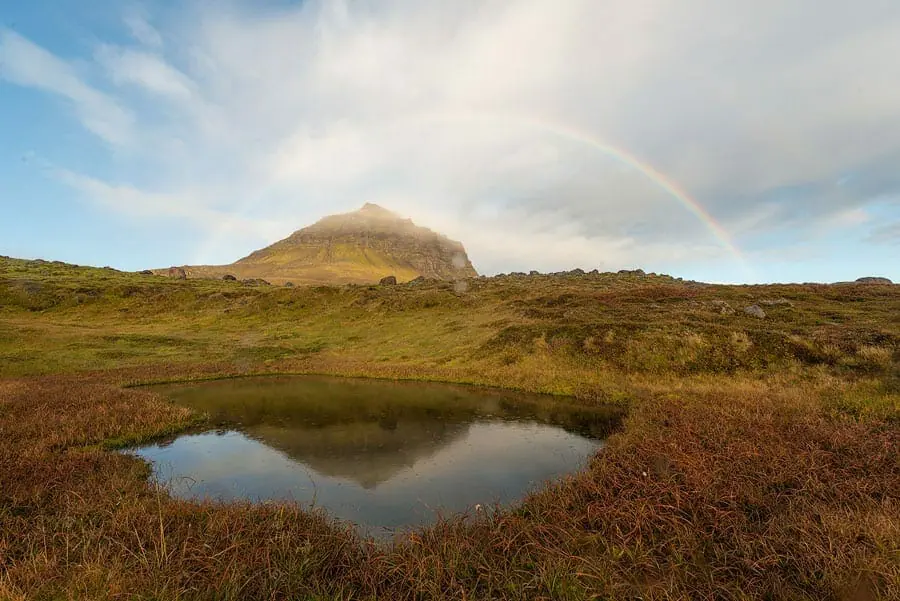
There was no need to guess at the ideal shutter speed or take test images!
Example Images & Creative Control
Varying shutter speeds can be utilized to provide detail, dynamic movement, and desired image attributes in a photo.
An image attribute is a specific visual effect obtained from different camera settings such as f-stop, ISO & shutter speed.
The photographer can control image attributes by varying shutter speeds.
This is where creativity, practice & foresight really come into play!
Download this helpful graphic which provides references for different shutter speeds & the results they provide.
Shutter Speed Image Attributes
The following shutter speed ranges are provided to help you visualize varying exposure times & their corresponding image attributes.
Only by testing each of these with your camera setup will you actually learn and understand the concepts.
The following images are unedited RAW files showing actual outcomes of varying shutter speeds without changes due to photo editing.
Shutter Speed Range: 1/8000th – 1/1000th Second
Best for fast-moving objects that need to be sharp, without motion blur.
Requires more light in the scene, wider f-stop, or higher ISO.
1/1000th Second Shutter Speed – Backpacking in the Canyonlands of Utah
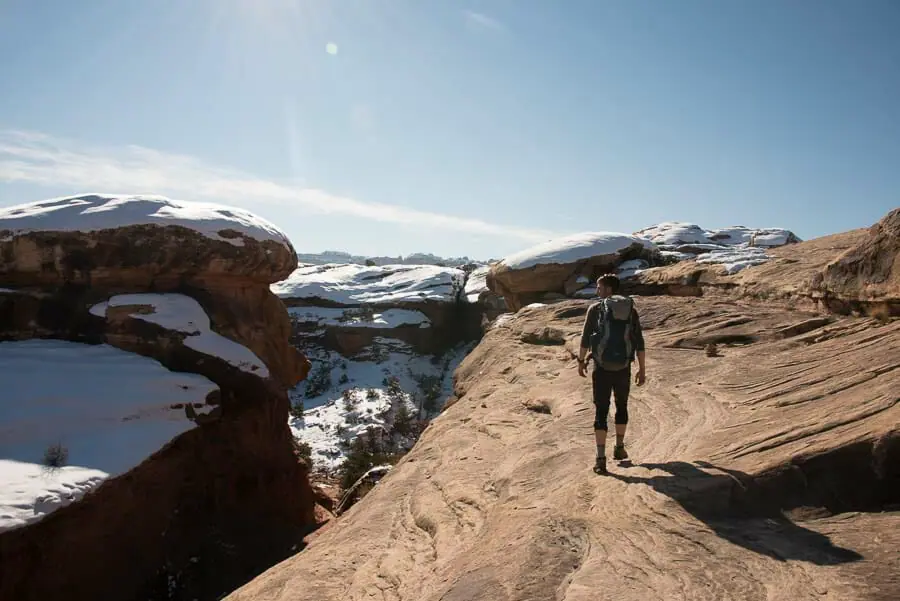
Shutter Speed Range: 1/500th – 1/250th Second
Perfect for overcast or partly cloudy days.
Great for quickly moving objects, achieving sharp focus, without motion blur, with less ambient light in the scene.
1/250th Second Shutter Speed – Glacier Climbing in Iceland
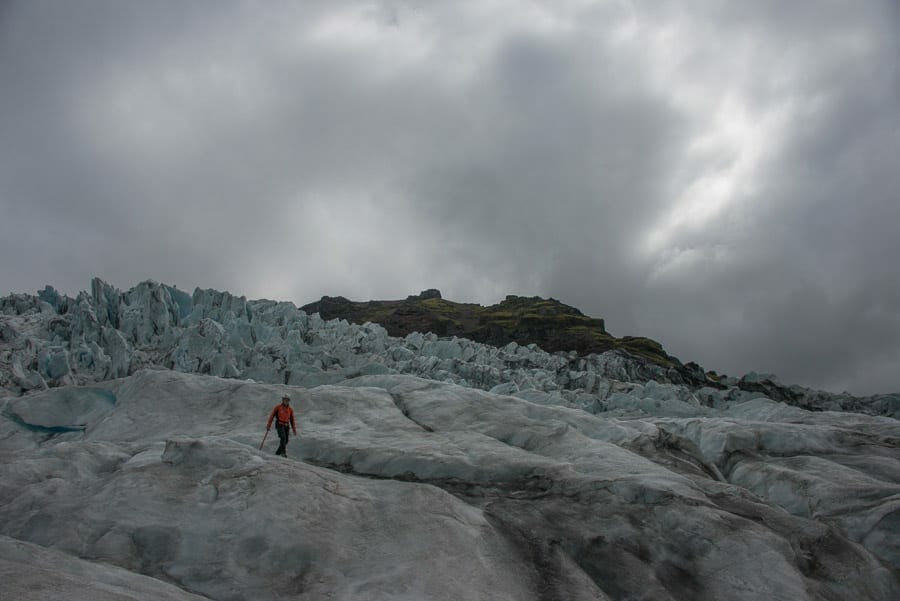
Shutter Speed Range: 1/125th – 1/15th Second
Perfect for landscapes, with a tripod, in low light, including sunrises and sunsets.
The image below shows the movement of crashing waves with motion blur.
Due to the shutter speed of 1/15th of a second, in the image below, water movement details are visible, producing a dynamic effect.
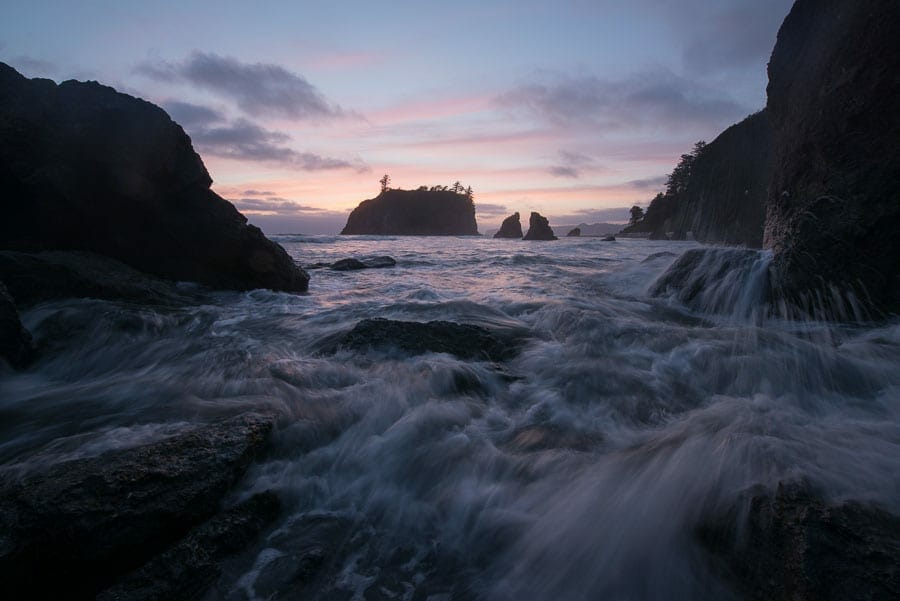
Shutter Speed Range: 1/8th – 10 Seconds
Long shutter speeds are used to create motion blur in landscape, street, and travel photography.
They also work well for capturing light trails behind vehicles, water movement, and cloud movement.
- Compared to the image above, the following two images show water movement with increased motion blur but decreased overall detail in the water.
- They excel at moving the viewer’s eyes through the composition with image attributes that would not have existed at shorter shutter speeds.
This method works well for showing movement in a subtle & calm manner.
Cool colors, as shown below, and taught in the Color Theory Photography Guide, also produce calming effects on the overall mood.
1/2 Second Shutter Speed – Twilight in Kauai, Hawaii
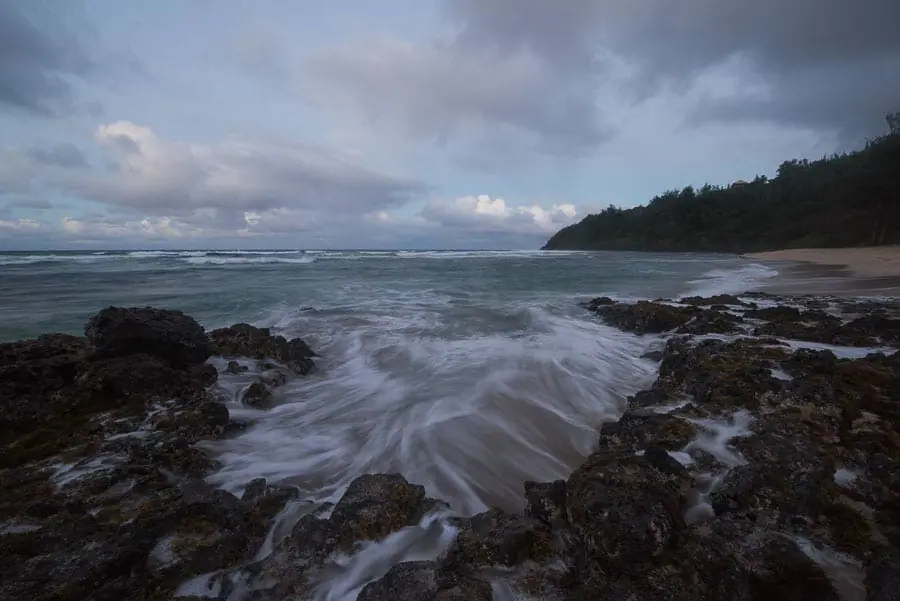
1 Second Shutter Speed – Exploring the Waterfalls of Oregon
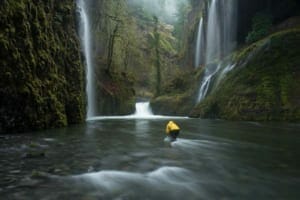
Shutter Speed Range: 15 Seconds – 2 Minutes
These slow shutter speeds are used for long exposure low light conditions including, milky way, star trail, and northern lights photography.
They also work well for long exposure photography of moving objects producing a motion blur effect in clouds and water.
15 Second Shutter Speed – Level 8 Aurora Activity in Iceland
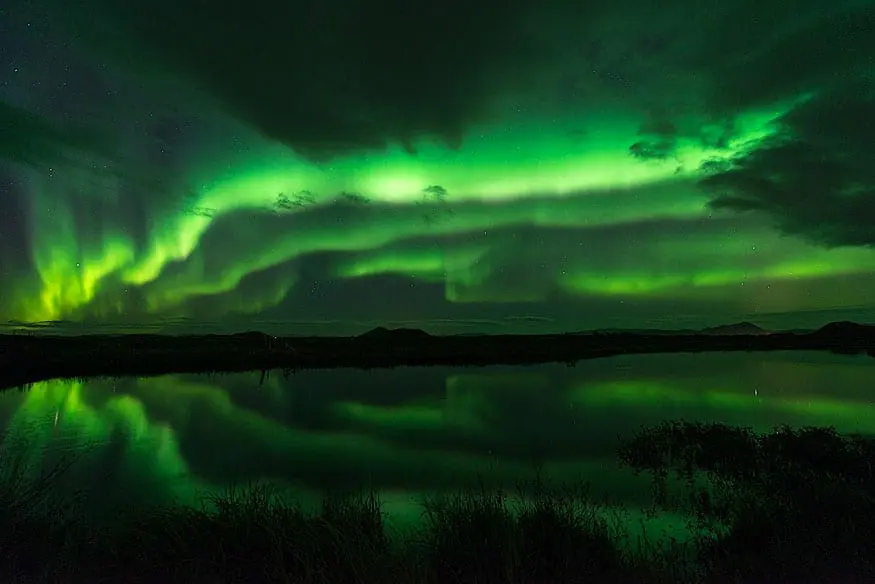
25 Second Shutter Speed – The Milky Way Over Crater Lake
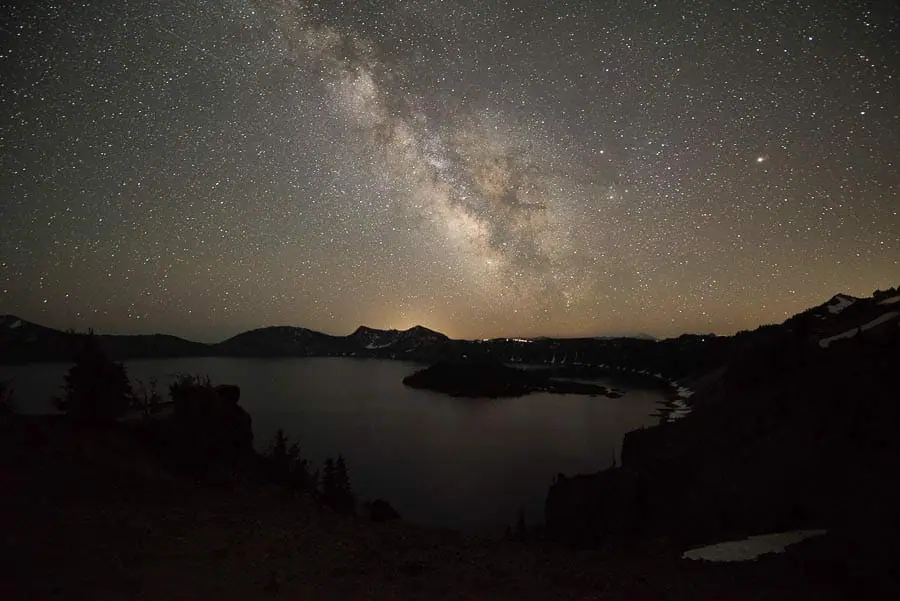
Best Shutter Speed for Handheld Photos
If the camera moves due to “hand shake” it will ruin your photos.
This hand movement produces very light motion blur causing out of focus images.
For the sharpest images, a tripod is recommended.
If you can’t use a tripod, then this trick works very well.
Max Handheld Shutter Speed = 1 / Focal Length
If you were shooting at 50mm focal length, you would want a shutter speed of 1/50th or faster.
Anything longer than 1/50th-second shutter speed would yield a blurry image.
This is an approximation, but it works well.
Improve Image Quality with Shutter Speed
As more light information is collected by the image sensor, over the allotted exposure time, more detail & data are displayed in the final image, resulting in less image noise.
There is a maximum amount of light information each pixel can collect, known as full well capacity.
When this value is exceeded, too much light is collected, and the pixel becomes “clipped”, also known as, “overexposed”, or “blown out”.
If this happens, the pixel becomes pure white and you can never recover the detail that it collected from the scene.
As the camera sensor collects more light, the image quality increases, given that none of the pixels are “blown out”.
- In nature, some things are very close to pure white, such as direct sunlight.
- If a few pixels become “clipped” it’s not a big deal.
The ideal exposure is achieved when each pixel collects as much light as possible, without any pixels “blowing out”, or becoming pure white.
The technique is called Expose to the Right (ETTR).
This video details the exact process.
Here are some examples of different exposures & their histograms.
Expose to the Right Example Images
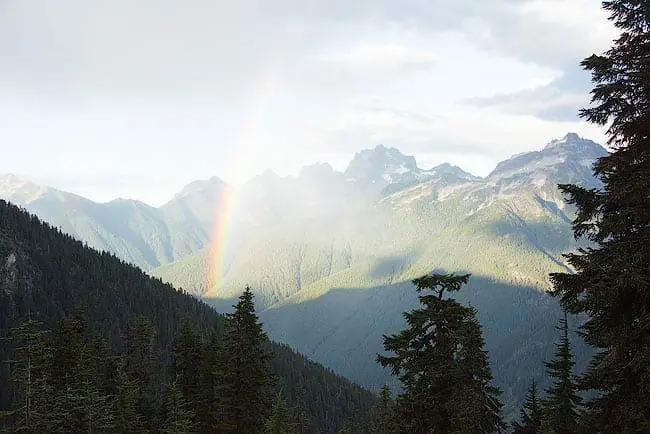
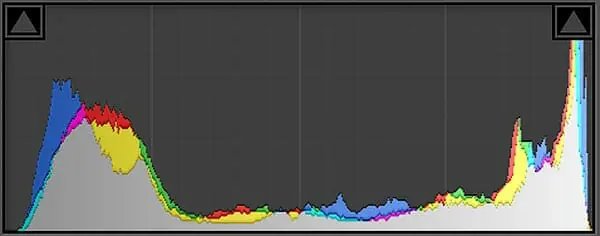
When I process the image above, I’ll darken it down to match what I actually saw while out shooting.
Using ETTR / Expose to the Right, the photographer can capture extra information from the dark parts of the scene than they could have with a standard exposure.
Without slightly overexposing the highlights, I would have lost data in the dark parts of the image, as shown in the following histogram. 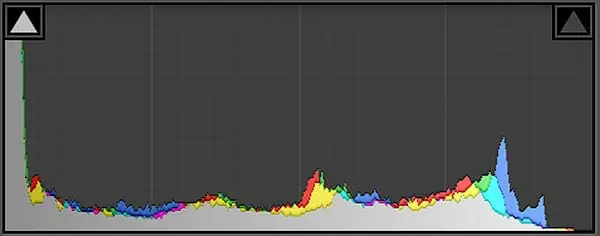
The next photo shows the RAW file above, with a 1 stop post-processing decrease.
This is what I actually saw when out shooting, but I have way more dark detail in my RAW file.
Expose to the Right RAW File Darkened in Post Processing
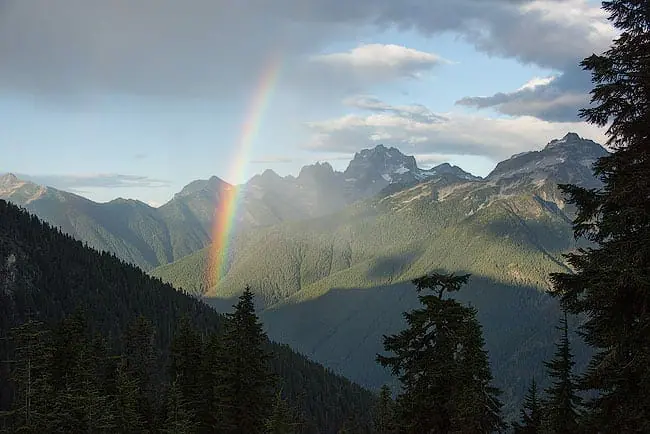
Test & Compare Shutter Speeds
Taking your camera outside and experimenting is the only way to really understand the best shutter speeds for every shot.
Here is what I would recommend.
Step 1: Select a single composition, and leave all of your other settings the same, except shutter speed.
Shooting a stream or moving water is great for this.
Prior to taking the image, take a mental guess at the image attribute a specific shutter speed may produce for a specific shooting scenario.
Step 2: Take 5-10 different images of the same composition, using different shutter speeds, and see what happens.
Step 3: Repeat steps 1-3 for varying shooting scenarios, subject speed, and lighting conditions.
Step 4: Review your images on the computer.
Zoom in at 100% and see the difference in each of the photos.
Take notes on what happened so you can easily remember.
Choosing the Correct Shutter Speed
The question, “What Shutter Speed Do I Use?”, leads down the path of dependence, without an actual understanding of the topic.
Instead, try asking yourself:
- What image attributes do I want to produce?
- What shutter speed is required to produce it?
These questions lead down the path of independence and problem-solving.
This is where true learning takes place.
All of the information above provides the foundation for selecting the best camera settings using the Photography Exposure Triangle.
How to 10X Your Learning Speed
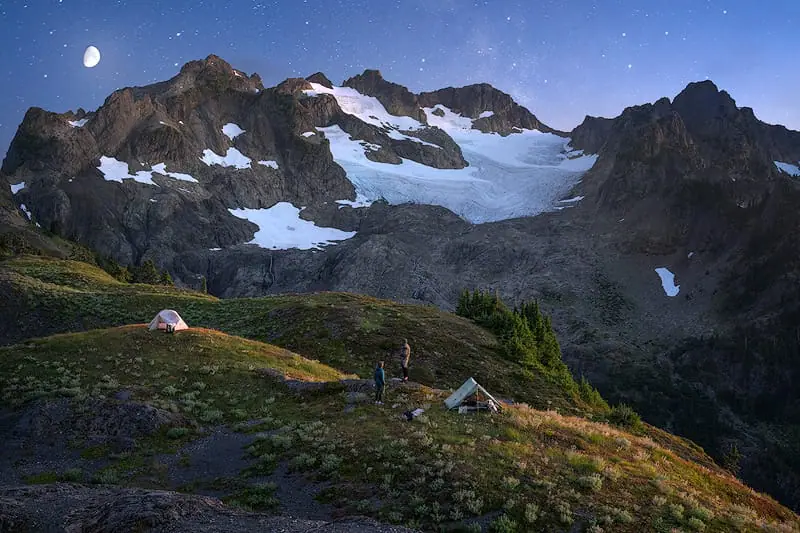
The best way to improve quickly is by learning firsthand from someone that’s optimized their skills, over a decade or more through trial and error.
You can’t read blogs and watch internet videos to do this.
I offer workshops & tours for all skill, fitness, and age levels.
Over a 3-day weekend, I can teach you everything I know, plus provide 1 on 1 feedback that will quickly improve your skills.
I’ve seen students learn more in a 3-day trip than they have in 20 years of trying to learn on their own.
Check out my workshops & tours, right here.
